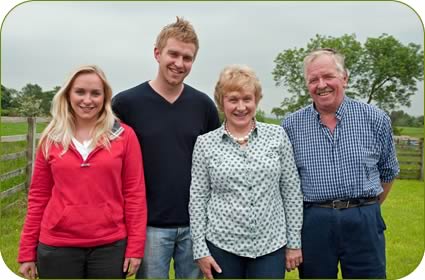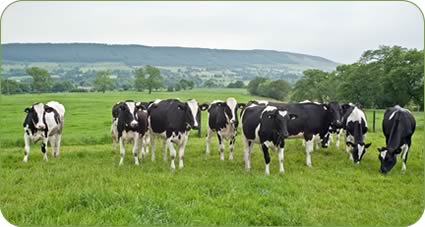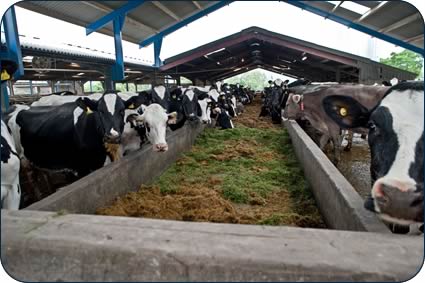Jennifer MacKenzie is an agricultural photo journalist with almost 30 year's experience. Operating from her base in Cumbria, Jennifer undertakes mainly industry-related freelance writing and photography.
Improving Cow Comfort Reaps Benefits
Improving cow comfort and health, as well as feeding management, has been pivotal in increasing profitability and yields at Mason House Farm, Bashall Eaves, near Clitheroe.
John and Sarah Hartley and son Ben have achieved their objectives set four years ago on the 325-acre tenanted farm to increase cow numbers in the pedigree Roughwood herd, increase milk yield and improve dry cow facilities.
 |
John and Sarah Hartley with daughter and son Louise and Ben |
Ben Hartley returned to work at home after university more than five years ago and a primary objective of the family has been to maintain and increase farm profit to allow for future capital expenditure over the next decade.
It is one of six monitor farms established in the Northwest through the RDPE Northwest Livestock Programme managed by Myerscough College and delivered in Lancashire by Myerscough with Cumbria Farmer Network and Reaseheath College managing the farms in Cumbria and Cheshire respectively.
Herd numbers have increased from 140 cows in 2011 to 171 cows in May this year. The milking cows are housed year round and milked through three Lely robots.
Out of parlour feeders, which were used prior to the installation of the first two Astronaut A3 robots four years ago and replaced an old abreast parlour, have been kept as part of the feeding system and since replaced with Lely feeders to fit in with the computerised system.
Milk yields have steadily risen to approach the Hartleys’ target of 10,000 litres a cow - from 7,500 litres four years ago to a rolling annual yield in May this year of 9,538 litres for 152 cows in milk and margins have been maintained, despite the challenging year for forage production.
 |
In calf heifers |
With the help of Kite Consulting’s Ros Hughes, the Hartleys began by setting targets to improve the business as well as using monthly costings with bi-monthly meetings to help pay more attention to detail.
“Together we identified ‘bottlenecks’ which were holding the herd back and one of the key areas we focused on was dry cow management,” said Ros.
“Previously, the dry cows were run with the milkers so separate dry cow housing was a priority,” she said.
A new dry cow building was erected in autumn 2010 which was initially tried as a composted bed but this was abandoned because of the damp climate. Other materials tried included straw and sawdust but it was found to be too expensive to maintain long term, lime ash bedding was also trialled.
However, since the installation of 28 cow comfort cubicles in October 2011, deep sand bedding has been used to manage the dry cows more effectively.
“Improvements in dry cow housing were also coupled with targeting dry matter intake in their diet with a more fibrous diet of silage, straw to keep potassium levels down and a high quality dry cow nut. That is working well and we’re seeing improvements in the early lactation as well as reduced incidence of milk fever and metritis,” said Ros.
Another area targeted was feed management for the milking cows. Silage and brewers grains are fed through a trough while concentrates are fed through the out of parlour feeders and robots at a rate of 0.33kg per litre.
A weigh cell has also been fitted to the loading shovel to monitor forage intakes.
The previous size of the feed trough allowed less than one foot of space per cow. By doubling the length of the trough to allow two feet per cow, this has improved dry matter intakes, giving cows a more balanced diet, particularly in early lactation.
 |
The extended feed trough |
Overall dry matter intakes have increased from 21kg a head a day to 23kg. The long term aim is to increase intakes to 24kg/ head/day.
This area has since been roofed over to increase the number of cubicles by 20. The open ridge also improves ventilation.
Cow movement and flow in the buildings was also analysed and re-siting the out of parlour feeders, extending the feed trough and installing a third robot in March 2012 reduced standing time and negative behaviour, such as bullying, and improved lying down and cudding time.
Foot treatments have been reduced by 20% with the majority of the improvement being a reduction in sole ulcers.
Ben Hartley said: “Having access to a large network of knowledge from industry specialists to farmers who were willing to share ideas and information has been the biggest benefit of being a monitor farmer. The whole process has been very worthwhile.
“A number of specialists at meetings and Kite’s Ros Hughes, all emphasised the importance of feeding consistent high quality forage and increasing access to feed. We have extended the feed trough and moved from two to three cuts of silage which has lifted yields, while maintaining concentrate feed levels.”
Grassland is a mixture of permanent pasture and short-medium term leys, including 25 acres of rough grazing. Sheep are taken on short term keep in the winter.
To improve grassland, a limited amount of reseeding and overseeding was undertaken from 2010 to 2012. All fields were soil tested and as a result pH levels were found to be low so lime was applied as required. P and K levels were good so mainly straight N is now applied and compound fertiliser used only when necessary.
With the move from two to three cuts of silage, the fertiliser policy was changed to allow earlier cutting dates.
For the future, investment may be made in zero grazing equipment. During June, employing a contactor on a daily basis, grass was zero grazed to help reduce feed costs.
 |
cattle housing |
Rubber matting could be an option to further reduce lameness and out of parlour feeders will probably be re-sited to a better position in the building.
Continued improvement of grassland and a third silage clamp are also long term objectives.
“We won’t change anything dramatically but we will continue to work with our vet and nutritionist to monitor cows and push constant improvement,” said Ben.
“Next year we plan to erect another building to house all the youngstock at Mason House. Long term we may be milking 200 cows through four robots,” he added.
Monitor farm facilitator Robert Burrow, of Myerscough College, said there were 70 farms on the database for meetings and half had attended at least three of the meetings.
“Many of the farmers will have taken away ideas from the meetings and adapted them to their own systems. It has been a good experience to witness the changes made at Mason House and we have had very positive feedback.”
| Production goals and achievements | ||||||
| KPI | Oct 2009 | Mar 2010 | Mar 2011 | Mar 2012 | Mar 2013 | Target |
| Annual av yield/cow (litres) | 7,763 | 7,653 | 8,491 | 8,894 | 9507 | 10,000 |
| Conc cost ppl | 10.07 | 8.17 | 6.9 | 7.57 | 8.55 | 8 |
| Feed rate kg/litre | 0.42 | 0.43 | 0.31 | 0.33 | 0.32 | 0.32 |
| Annual litres/forage | N/A | 1,463 | 1,010 | 2,359 | 1,112 | 2,500 |
| Litres cow/day | 26 | 25.8 | 27.1 | 31 | 29.4 | 30 |
| DM intake | N/A | N/A | 21 | 22 | 23 | 24 |
| Rolling annual totals (Kite Milk Monitor) | ||
| - | May 2013 | May 2012 |
| Cows in herd | 165 | 141 |
| Cows in milk | 146 | 114 |
| Cow calvings | 112 (68%/year) | 99 (70%/year) |
| Heifer calvings | 51 | 32 |
| Annual yield/cow/lit | 9,538 | 9,042 |
| Annual yield/cow forage | 907 | 2,736 |
| Daily milk/litre | 4,311 | 3,470 |
| Conc/per litre | 0.33kg | 0.33kg |
| Marg all feeds/litre | 19.70p | 20.31p |
| Marg all feeds/cow | £1,833 | £1,833 |

